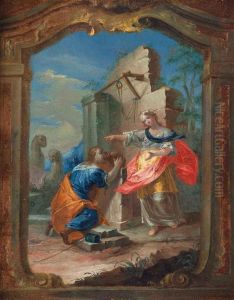Canonico Biagio Bellotti Paintings
Canonico Biagio Bellotti was an Italian painter and cleric born in Busto Arsizio in 1694. His artistic career is primarily associated with the Lombardy region of Italy, where he made significant contributions to the Baroque and Rococo movements. Bellotti's work includes a range of religious and secular subjects, often characterized by their vividness and attention to detail.
Bellotti's early life is not well-documented, but it is known that he was deeply involved in the church, which was common for many artists of the period. His status as a canon, a clergyman belonging to the chapter or staff of a cathedral, did not hinder his artistic pursuits. In fact, his religious position likely provided him with opportunities to receive commissions for ecclesiastical art, such as altarpieces, frescoes, and other devotional works.
Throughout his career, Bellotti developed a reputation for his skillful use of color and light, capturing the essence of the Rococo style that was popular during his lifetime. His works were marked by graceful figures, light-hearted themes, and often included playful cherubs, a common motif in Rococo art. Despite the lack of extensive records of his patrons and commissions, it is evident from his surviving works that he was quite prolific.
In addition to his religious works, Bellotti also painted portraits and landscapes, displaying versatility across different genres. His landscapes, in particular, are noted for their pastoral tranquility and naturalistic details, reflecting the influence of the burgeoning appreciation for nature during the 18th century.
Bellotti lived a long life, passing away in 1789 in his hometown of Busto Arsizio. His legacy is preserved in the local churches and institutions where his works remain on display, as well as in the collections of art aficionados who appreciate the art of the Italian late Baroque and Rococo periods. Despite not having the international renown of some of his contemporaries, Bellotti's work is a testament to the vibrancy and richness of 18th-century Italian art.
